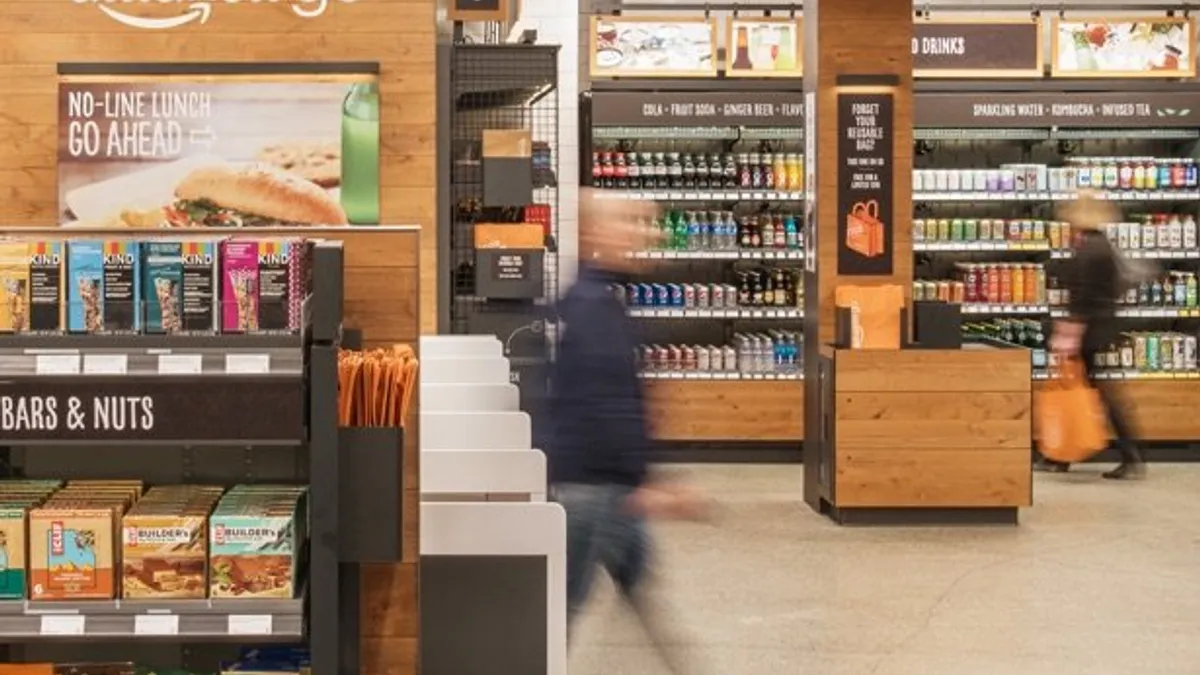Dive Brief:
- Amazon Go stores have officially made their way into multiple markets, presenting customers with a cashierless, "just walk out" shopping experience for the first time. Early reports from experts analyzing shopper behavior at Amazon Go stores are showing strong results with high sales, repeat customers and lengthy visits.
- A report from inMarket analyzed shopper trends at five stores in Seattle and Chicago over a 60-day period, and found that the average length of a shopper’s visit to Amazon Go is 27 minutes. About 44% of customers visited multiple times over the study period. inMarket also found that traffic was heavier on weekdays than weekends, though some stores were closed on weekends. Peak visit times aligned with breakfast and lunch customers, according to the results.
- Brick Meets Click also conducted a report on Amazon Go shopper behavior at the first store launched in Seattle, and found that Amazon Go could generate an estimated $2,700 in annual sales per square foot, higher than any other retailer except Apple — and that number could increase. Based on its observations, Brick Meets Click also estimates that Amazon Go will generate about 50 inventory turns per year, which is four to five times more than other typical retailers.
Dive Insight:
While Amazon Go is showing significant early success, inMarket suggests that the store concept is not necessarily a threat to grocers. The firm says this is partially because shoppers are treating Amazon Go as more of a convenience store or restaurant, rather than a grocery store.
The other major reason inMarket says grocery stores shouldn't see Amazon Go as competition, at least at this point, is because of the hours of operation. Of the six Amazon Go stores operating in San Francisco, Seattle and Chicago, four of them are closed on weekends — the prime time for foot traffic in traditional grocery stores.
Despite the closures, however, Business Insider reported that those four stores are marketed as more of a destination for meals and snacks, while the two Seattle stores open on the weekends are being promoted as grocery stores. If that is the case, grocers should indeed have their eye on Amazon Go as possible competition, especially if Amazon plans to expand its more grocery-focused stores throughout the U.S.
According to Brick Meets Click, Amazon has plans to open 3,000 Amazon Go stores nationwide in the next few years. This is highly ambitious, but it appears that the strong results so far are good indicators that there may be an appetite for more stores. Still, these stores are in large urban areas that are often at the forefront of tech trends, and there are only so many of these metro areas in the U.S. To ensure customer adoption in other types of markets — from small towns to suburbia — Amazon may need to consider some additional pilot locations and connect with a wider variety of customers to understand their preferences and shopping behaviors.
So far, much of the traffic to Amazon Go stores are from repeat customers likely seeking out convenient grab-and-go meals or quick grocery items. Analysis from inMarket also noted that the relatively long length of shopper visits could result from sheer curiosity as customers take in the novelty of the store. In time, it wouldn't be surprising if the average visit dropped as customers become more familiar with Amazon Go — and as the technology helps shoppers become more efficient.
While Amazon Go is the original innovator of the cashierless system, other retailers may not be far behind in experimenting with this model. Sam's Club has announced that its first Sam's Club Now store will soon open in Dallas, and it will follow the cashierless concept using its Scan & Go technology. There's little doubt that Sam’s Club Now will be a direct competitor of Amazon Go — and Sam's Club is already well established in grocery, whereas Amazon hasn't been particularly reliable in the space.
Other grocers, such as Schnucks and Albertsons, are adopting new technology quickly, and although they are not at the point of offering kiosk-free, cashier-free shopping, their willingness to employ technology shows that such a format may be the grocery store of the future.
One final consideration: If Amazon chooses to deploy its Amazon Go concept to Whole Foods Market locations nationwide, grocers better brace themselves for a shake-up.
















